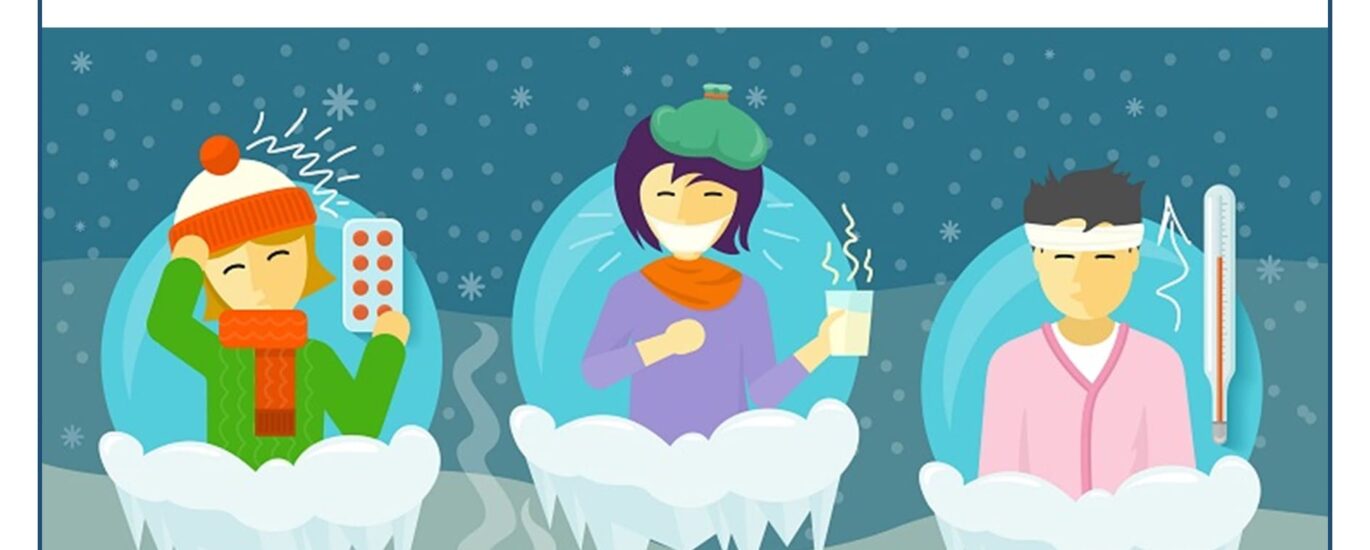During the winter, colder temperatures and lower humidity levels can lead to an increase in certain health issues. Common winter diseases include respiratory infections, skin conditions, and other health concerns exacerbated by cold weather. Below is an overview of some of these conditions and general management strategies.
Common Winter Diseases
COLD AND FLU (INFLUENZA)
Symptoms: Runny nose, sore throat, cough, fever, fatigue, body aches.
Prevention:
- Get vaccinated (flu shot).
- Wash hands frequently with soap.
- Avoid close contact with infected individuals.
- Maintain a healthy immune system through good nutrition, sleep, and regular exercise.
Management:
- Rest and stay hydrated.
- Over-the-counter medications for symptom relief.
- Seek medical advice if symptoms worsen or persist.
COMMON COLD
Symptoms: Mild cough, nasal congestion, runny nose, mild fever, sneezing.
Prevention:
- Regular handwashing.
- Avoid touching the face with unwashed hands.
- Use hand sanitizers with at least 60% alcohol.
Management:
- Stay hydrated.
- Use nasal saline sprays, steam inhalation.
- Rest and avoid overexertion.
PNEUMONIA
Symptoms: Chest pain, severe cough, high fever, chills, difficulty breathing.
Prevention:
- Pneumococcal vaccine (especially for elderly and high-risk individuals).
- Proper management of flu and colds to prevent secondary bacterial infections.
- Avoid exposure to extreme cold and take measures to stay warm.
Management:
- Seek medical attention immediately.
- Antibiotics if bacterial pneumonia is diagnosed.
- Rest, fluid intake, and breathing exercises as advised by a healthcare professional.
BRONCHITIS
Symptoms: Persistent cough, chest discomfort, fatigue, shortness of breath.
Prevention:
- Avoid smoking or exposure to second hand smoke.
- Practice good hand hygiene.
- Get vaccinated for flu.
Management:
- Drink plenty of fluids.
- Use humidifiers to ease breathing.
- Avoid irritants like dust and smoke.
ASTHMA ATTACKS
Symptoms: Wheezing, coughing, shortness of breath, chest tightness.
Prevention:
- Avoid triggers such as cold air, smoke, and allergens.
- Take prescribed preventive asthma medication regularly.
- Wear a scarf over the nose and mouth to warm the air before breathing in cold environments.
Management:
- Use prescribed rescue inhalers during attacks.
- Keep indoor air humidified but mold-free.
SEASONAL AFFECTIVE DISORDER (SAD)
Symptoms: Low energy, depression, mood swings, changes in sleep and appetite.
Prevention/Management:
- Increase exposure to natural sunlight or use light therapy.
- Stay active with regular exercise.
- Maintain a healthy diet rich in fruits, vegetables, and whole grains.
- Seek counseling or therapy if symptoms persist.
FROSTBITE AND HYPOTHERMIA
Symptoms (Frostbite): Numbness, skin discoloration (blue/white), hard or waxy-looking skin.
Symptoms (Hypothermia): Shivering, confusion, slurred speech, fatigue, shallow breathing.
Prevention:
- Wear layers of clothing and stay dry.
- Protect hands, feet, and face from extreme cold.
- Limit time outdoors in freezing temperatures.
Management:
- Seek emergency medical care for hypothermia or severe frostbite.
- Warm the body slowly, using blankets or warm (not hot) water for frostbitten areas.
DRY SKIN AND ECZEMA
Symptoms: Itchy, red, dry, or cracked skin.
Prevention:
- Keep skin moisturized by using lotions or ointments.
- Avoid long, hot showers, which can dry the skin.
- Use humidifiers to add moisture to indoor air.
Management:
- Apply moisturizing creams immediately after bathing.
- Use gentle, fragrance-free skin products.
- For severe eczema, seek medical advice for prescription treatments.
GENERAL WINTER DISEASE MANAGEMENT TIPS
Boost Immune System
- Eat a balanced diet rich in vitamins (C, D), antioxidants, and minerals (zinc).
- Stay hydrated by drinking enough water.
- Get regular exercise to maintain immune health and circulation.
- Ensure adequate sleep (7-9 hours a night).
Stay Warm
- Dress in layers, covering extremities (hands, feet, ears) to prevent heat loss.
- Use heating devices indoors but ensure proper ventilation to avoid dryness.
- Avoid prolonged exposure to cold or damp environments.
Maintain Hygiene
- Wash hands regularly to prevent the spread of infections.
- Disinfect frequently touched surfaces (e.g., door handles, phones).
- Sneeze or cough into tissues or elbows to avoid spreading germs.
Ventilation and Humidity
- Keep indoor environments well-ventilated, especially in areas where people gather.
- Use humidifiers to prevent dry air, which can irritate the respiratory system and skin.
Stay Active
Regular physical activity indoors can help boost immunity, maintain mental health, and combat sedentary winter lifestyles.
By adopting these preventative measures and management strategies, you can reduce the risk of winter diseases and stay healthy throughout the colder months











